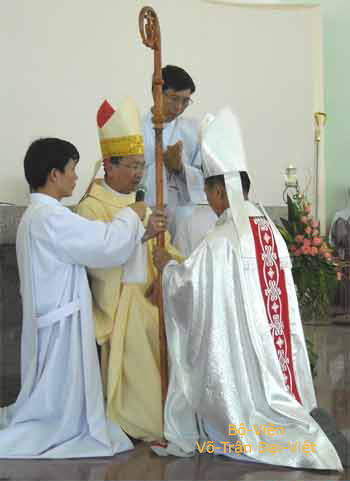II.
THE MEDIEVAL WEAPONS
3 - The Pole-Arms
THE CUDGEL
« TRƯỢNG »
仗
The Cudgel - Trượng is a term for refering to two categories :
1 - The category of Cudgel - Trượng (杖), whom the name is writen in Hán character with the Key « Wood - Mộc 木 » , is the one of Cudgel having Two similar Ends, comprising :
- The Judicial Cudgel (Hình-Trượng - 刑 杖) is the Stick employed in punishments for hitting guilties according to One among Five Criminal Sentences :
1. Suy (Torture by Flogging with a Judicial Whip ) ;
2. Trượng (Torture by Beating with the Stick (Gậy - still called « Hèo ») ;
3. Đồ (Conviction to execute hard works, as to clean up war elephants cages, etc.) ;
4. Lưu (Exile into desert places) ;
5. Tử (Killing ).
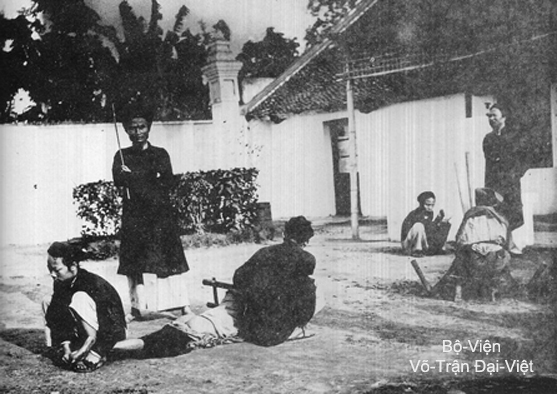
Punishments
for hitting guilties « Suy » (To Flog on the Back)
NGUYỄN Dynasty ( Late 19th Century - Early 20th Century)
(Photo Credit : Nguyễn Khắc Ngữ)
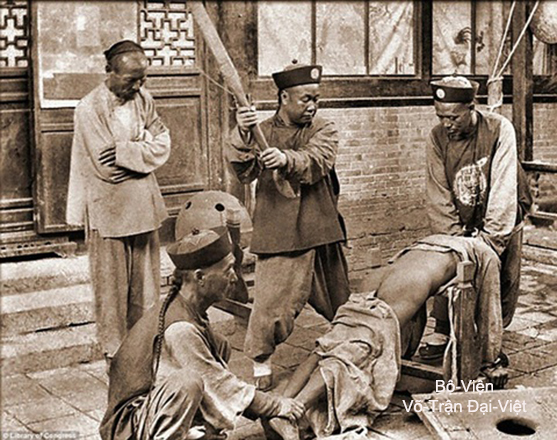
Punishments
for hitting guilties « Trượng » (Beating with the Judicial Cudgel)
QING Dynasty ( Late 19th Century - Early 20th Century)
2 - The category of Cudgel - Trượng (杖), whom the name is writen in Hán character with the Key « Man - Nhân 人 », is the one of Cudgel having Two Dissimilar Ends, still called Cudgel Bổng (棒), comprising :
- The Ceremonial Cudgel - Nghi-Trượng (儀 仗) having an Armed End - usually that's the Halberd Blade, called « Khể Kích » (棨 戟) - used in the escort of noble Mandarins when they came out of palace. However, at LÊ Dynasty Period, the Blade of Antique Halberd was employed for the Ceremonial Cudgel and it was called « Ceremonial Halberd Qua Cudgel - Qua Nghi Trượng » (戈 儀 仗) that country population named « Owled Beak Halberd Cudgel - Qua Mỏ Cú ».
As for the Ceremonial Cudgel (Nghi-Trượng 儀 仗) employed in Cultual Rites of Temples, it owns one end armed with Eight Precious Attributes (Bát Bữu 八寶 ) :
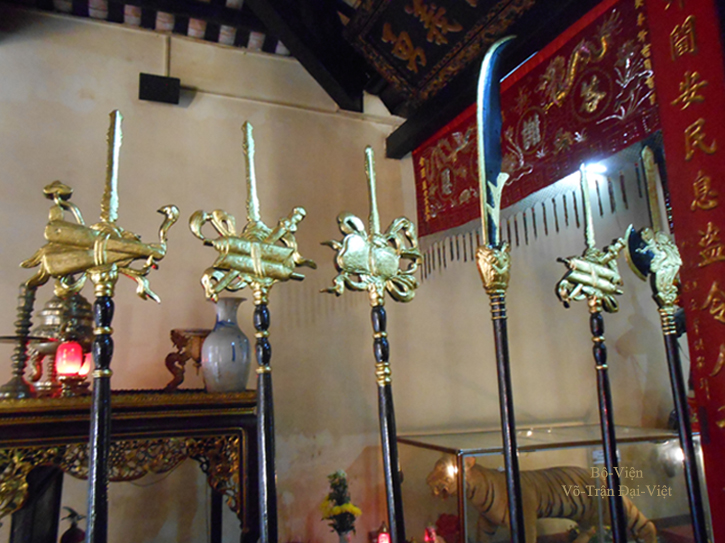
Ceremonial Cudgel « Nghi-Trượng » (禪 仗), holding Precious Taoist Attributes,
layed in Temple of Left Wing Generalissimo LÊ Văn Duyệt at Saïgon, South Việt-Nam.
(Photo Credit : Bình-Định Sa-Long-Cương France)
While for those used in Imperial Court's Rites (during the Warrior Dance of Eight Ranks of Eight Mimes - Múa Bát-Dật) the Superior End of Ceremonial Cudgel curves at the bottom :
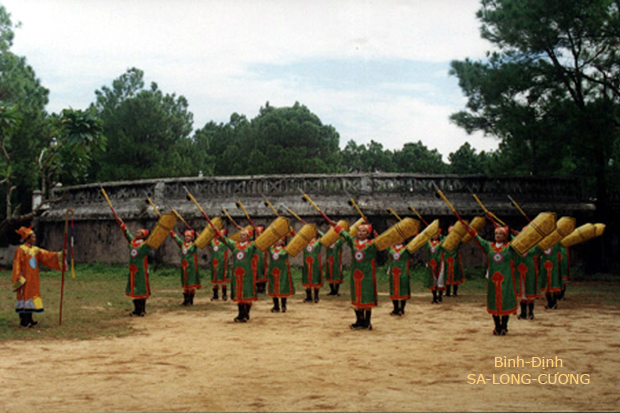
The Ceremonial Cudgel - Nghi-Trượng (儀 仗) employed
during the Dance of Eight Ranks of Eight Mimes - Múa Bát-Dật
at the old Imperial Capital of Huế.
(Photo taken in 2002).
As for the one in Catholic Churches (during the Investiture Rites) the Superior End of Ceremoniel Cudgel curves in volute :
The « Pastoral Crozier » employed during |
« The Set of Ceremonial Cudgels holding Precious Eight Attributes » ( Photo Credit : Vũ Thành Nam - http://ubdkcgvn.org.vn ) |
However, concerning the Ceremonial Cudgel (Nghi-Trượng 儀 仗) inherent in Catholic Church in Việt-Nam, apart from the fact that this Ceremonial Cudgel is designed in the western style under the form of « Pastoral Crozier », this one comprizes also a kind of « Ceremonial Cudgels Set holding Precious Eight Attibutes - Bộ Nghi-Trượng Bát-Bữu » designed in eastern style, drawing one's inspiration from the one holding Precious Eight Attributes in Temples from Three Religions : Bouddhism, Taoïsm and Confucianism.
- The Dhyana Cudgel - Thiền-Trượng (禪 仗) originated from India, called in Sanscrit « खक्खर Devanagari » (Khakkhara, “beggar's staff”): that's the Pilgrim's staff of Buddhist Monks, having an End designed according to several models whom two main models :
A) - The Model with Shakra (called Universe Ring - Càn-Khôn Quyện) from Vietnamese Bouddhidst Monks :
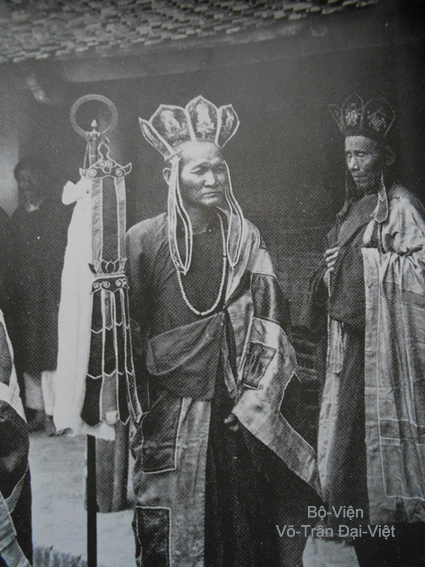
The Dhyana Cudgel « Thiền-Trượng » (禪 仗) from Buddhist Monks.
(Việt-Nam -
B) - The Model from Chinese Bouddhidst Monks, stylized - in six circles (symbolizing Six Karmic Transmigration Ways) curved according to Pelvic-Belt-shaped, or into Cloudflakes-shaped, etc. - and holding 12 metal rings (symbolizing Twelve Karmic Causal Relations). This cudgel became a Weapon truthly efficient in the hands of Superiors Monks having as name Perfume Cudgel (Phương-Trượng 芳 仗) dedicated to them during the investiture.
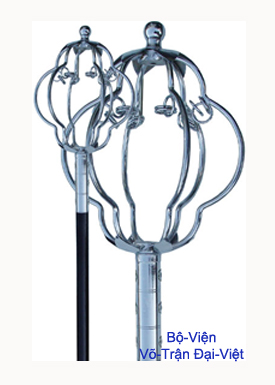
The Dhyana Cudgel « Thiền-Trượng »
(禪 仗)
(China - Re-Enactment for training in Martial Arts Drill Halls)
(Photo Credit : Wing Lam Enterprises)

Shao-Lin Chinese Master demonstrating
the Dhyana Cudgel « Thiền-Trượng » (禪 仗) Wielding
in Vancouver (Canada).
(The 12 Rings are taken away for lightening)
(Photo Credit : Vancouver Shaolin Martial Arts Academy)
C) - As for the Model of Staff in shaped Wooden Lath - as well erronemously called « Dhyana Cudgel - Thiền-Trượng (禪 仗) » in Việt-Nam - it is in reallity called in Japanese « kyosaku (or keisaku) Cảnh-Sách 警 策 (Waking up Staff) ». It is used in the pratice of ZaZen from RINZAI School in Japan for wakening up the Adept being in prey to the drowsy state.
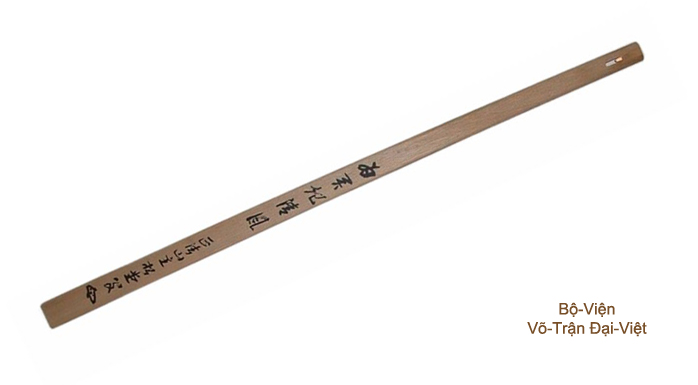
Traditional shaped Wooden Lath Staff called « Kyosaku (or Keisaku) Cảnh-Sách 警 策 »
from « RINZAI » Zen School in Japan.
(Photo Credit : Gakuro)
Later, as Buddhist Followers have only made researches on the Principle of Doctrine in order to preach, but they could not learn the Methodology of Dharma in view for practising the spiritual improvement, they have transformed this Cudgel « खक्खर Devanagari » (Khakkhara, “beggar's staff”) into a Ceremonial Cudgel like those in the Catholicism. Then after why, they have transformed this latter into a symbol for becoming the Holly Cudgel (Tích-Trượng 錫 仗) following the example of statuary imagery from Bodhisattva Kshtigharba.
Finally with the time, they have been transformed this Holly Cudgel (Tích-Trượng 錫 仗) - a Stick of Trip for Bouddhist Monks setting out their food - into a Dharma Cudgel (Pháp-Trượng 法 仗) by using intellectual speculations for giving explanations of this Cudgel which are nothing to see with the Esoteric Science of Buddha Dharma from the Founder Çakyamûni Buddha.
- The Dragon-Cudgel - Long-Trượng (龍 仗), having an End designed according to the Dragon-Head-shaped, used as Stick of Trip for Taoist Monks and Aristocratics. It's also a Weapon truthly dreadful in the hands of Martial Arts Experts.
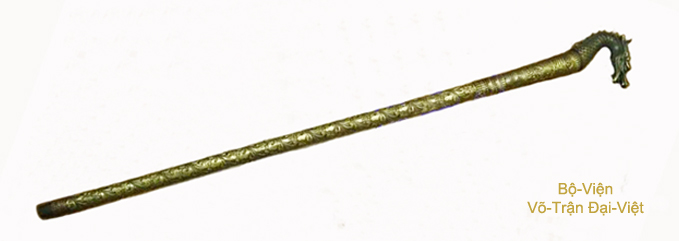
The Dragon-Cudgel
« Long-Trượng »
(龍 仗)
- The Wolf Teeth Cudgel - Lang-Nha-Trượng (狼 牙 仗), still called Cudgel Lang-Nha-Bổng (狼 牙 棒), having an End designed according to the Oblong-Club-shaped, raised of curved points, fluently in use under Lý Dynasty (1010~1225) and Song Dynasty - 960~1279) :

The Wolf Teeth Cudgel
« Lang-Nha-Bổng »
(狼 牙 棒)

The Wolf Teeth Cudgel « Lang-Nha-Bổng » (狼 牙 棒)
(China - Re-Enactment for training in Martial Arts Drill Halls)
- The Snake-Cudgel - Xà-Mâu-Trượng (蛇 矛 仗), having an curved End like the Cobra's neck, used as Stick of Trip for old men in Việt-Nam :
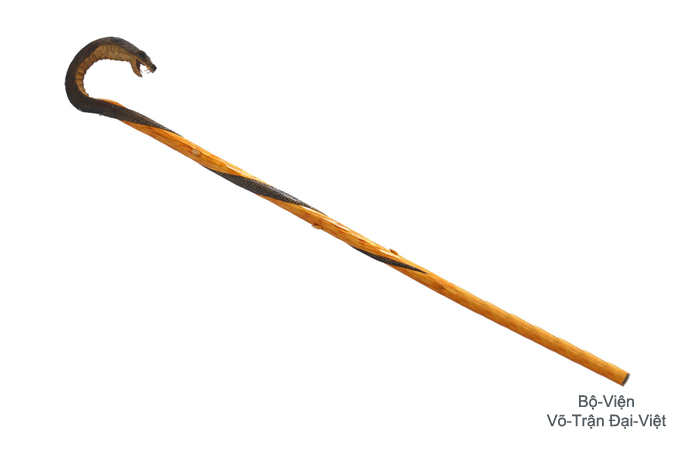
The Snake-Cudgel
« Xà-Mâu-Trượng »
(蛇 矛 仗)
- The Moon Cudgel - Nguyệt-Trượng (月仗), having an End designed according to the symbolic Moon's-Quarter-shaped. That's a Weapon extrapolated from the Spade and specific to Buddhist Monks of Shao-Lin Temple School.
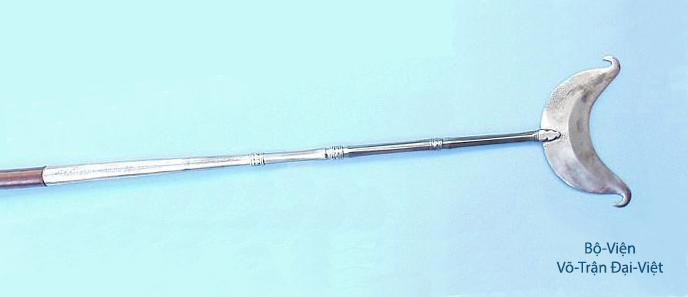
The « Moon-Cudgel »
« Nguyệt-Trượng »
(月仗)
(Photo Credit : Gavin Nugent, swordsantiqueweapons.com)
- The Sun-Moon Cudgel - Nhật-Nguyệt-Trượng (日月仗), having an End designed according to the symbolic Sun-shaped, an End designed according to the symbolical Moon's-Quarter-shaped :
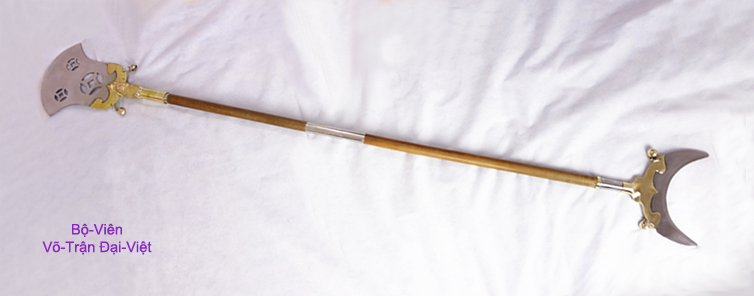
The « Sun-Moon Cudgel »
« Nhật-Nguyệt-Trượng »
(日月仗)
( Photo Credit : haoxinwu.com )
Committee of Martial Arts Masters TRỊNH Quang Thắng. |
Copyright © 2004 - 2018 by ACFDV - All rights reserved.
